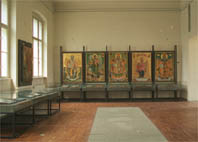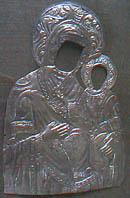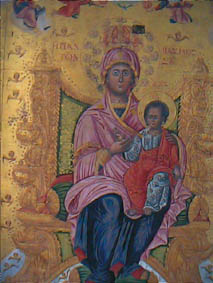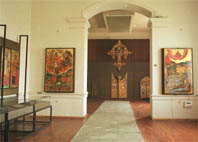|
The collection of icons of the Varna Archaeological Museum
exists from the very establishment of the archaeological museum
in 1906. Substantial tribute for its completion should be given
to archimandrite Inokentius from Sofia /1883 1976/ who was
a long year curator in the museum.
The icon-painting exhibition consists of both icons belonging to
the Museum and icons belonging to the Varna-Preslav bishopric.

|
The icon exhibition changed places many times at the Girls'
School, at the St. Athanasios Church to finally take its permanent
place in the Archaeological Museum.
Presently it consists of 130 icons and church plate chronologically
arranged. Part of the exhibits originate from the ecclesiastical
regions of the Varna Preslav bishopric and others, mainly
the earlier ones, have been brought from the southern Black
Sea regions /Bourgas, Sozopol/ or from Varna churches that
existed during the Mediaeval Period. |
Hall 32 Icons from 16th 18th century
The total change in the living conditions at the beginning of the
15th century that followed the termination of the Bulgarian state
and the independence of the Bulgarian church put an end to the development
of the elite art. The foreign domination, the ruining of churches
and monasteries, the scattering of their riches chased away from the
country many artists. Nevertheless, towards the end of the 15th century
in the inner part of the country new buildings and monasteries sprang
up over the ruins of the previous churches.
This hall represents icon-paintings of the Bulgarian Black Sea region,
from the villages of the Varna-Preslav bishopric, created during the
16th 18th century. It is quite variable and contradictory in character.
The contradictions arise from the collision of the conservative following
of the traditional painting schemes inherited from the previous ages
and pertaining to the historic conditions with the penetrating new
influences changing the aesthetic criteria.
In the older Varna Churches St. Athanasios, The Holly Virgin Panagia
and St. George are arranged icons depicting images of saints characterized
by their monumentality and expressiveness. Impressive is the contrast
modeling of the faces thus taking out the light hue against the dark
background. Of that kind are the icons depicting holidays from the
end of the 16th the beginning of the 17th century from the St. Athanasios
church exhibited at the bottom of the hall.
 For the modern influences of 17th 18th century are typical the icons
pained in miniature /St. George and St. Dimitrius 17th century, Deesis
18th century/ or anatomy in geometrical forms, or outlining of separate
details leading to a schematic drying of the images /St. Athanasios
17th century/. The richer decoration of the saints' clothes /St.
Spyridon and St Nicholas - 17th century/, the calligraphic diligence
in painting the hair /St. Athanasios 17th century/, the plastic
decoration of the halos and the frames of the icons /The Holly Virgin
Unfadable Rose - 18t century, Deesis 1789/ manifest a deviation
from the mediaeval tradition. All these characterize the new aesthetic
demands of the icon-painters working in the coastal villages and Varna.The
gold church plate contributed to the brilliance and the solemnity
of the religious rituals. The Bulgarian goldsmiths of the time were
masters in the filigree, the enamel, the black silver and other decorative
techniques that gave them possibilities for broad artistic achievements.
The decorative tradition of the silver repousse icons was brought
into The Balkan Peninsula from Byzantium.
For the modern influences of 17th 18th century are typical the icons
pained in miniature /St. George and St. Dimitrius 17th century, Deesis
18th century/ or anatomy in geometrical forms, or outlining of separate
details leading to a schematic drying of the images /St. Athanasios
17th century/. The richer decoration of the saints' clothes /St.
Spyridon and St Nicholas - 17th century/, the calligraphic diligence
in painting the hair /St. Athanasios 17th century/, the plastic
decoration of the halos and the frames of the icons /The Holly Virgin
Unfadable Rose - 18t century, Deesis 1789/ manifest a deviation
from the mediaeval tradition. All these characterize the new aesthetic
demands of the icon-painters working in the coastal villages and Varna.The
gold church plate contributed to the brilliance and the solemnity
of the religious rituals. The Bulgarian goldsmiths of the time were
masters in the filigree, the enamel, the black silver and other decorative
techniques that gave them possibilities for broad artistic achievements.
The decorative tradition of the silver repousse icons was brought
into The Balkan Peninsula from Byzantium.
The throne crosses arranged in the central showcase have been worked
out after models imported from Constantinopol, Athos and Russia. Often,
ready-made filigree plates cover a basic wooden cross that is decorated
with miniature carved relieves.


|
Hall 33 - Church Plate /17th 19th
century/
Goldsmith's Artistry /17th 19th century/
The incense-burners and the church lamps in the side showcase
resemble the patterns of old oriental torches and balsam vessels
typical for churches of various religions. All these cult objects
are distinguished by their high aesthetic value.
Halls 35 36 Icons from the Bulgarian Black Sea Coast 19th
century
In the towns along the coast various studios came forward. The
artistic value of the out-coming products was also various.
Famous icon-painters of that time were Dimitrius of Sozopol,
Nikola Sotiriadi of Constantinopol, Hadji Anagnosti, Gergi,
Constantine and others. They were united by the new revival
spirit of the time. The icon-painters, inspired by the diverse
and colorful folk art develop the achievements of the past adopting
some modern tendencies of the fashionable Western European art
and quickly uptake the Baroque orientation of art. Very often
new samples were imported from Athos /The Holly Virgin Portaitisa
Of Iver 1815/. Each painting bore the marks of newly arising
tastes and strivings /The Holly Virgin Pantovasilisa 1839,
painted by Hadji Anagnosti, the left side panel in Hall 35 or
the exceptional icon of St. Joseph Obruchnik and Christ Emannuil
of 1850 at the bottom of Hall 36/ |
Instead of vain lifeless images the saints' faces were depicted
close and understandable for the contemporary people. The image
of the man suffering for an idea, or dying in the name of victory
over the evil is represented by the following icons - St. Marina
second half of the 18th century, painted by Vionos, which is the
only known till present, icon of the saint, representing numerous
life scenes; St. Dimitrius and St. Minas- 1844, painted by Nikola
Sotiriadi and others.
Every icon-painter created a landscape typical only for his icons.
With the development of the art the icon painters got the possibility
to create multi grounded compositions with preferences to architectural
or landscape elements /St. Archangel Michael 1840, painted by
Nikola Sotiriadi; Sundays of the Blind 19th century, painted by
Dimitar of Sozopol/. That came as a result of the new perception
of reality.
Hall 37 Icons by Tryavna Icon Painters
The economic, political and cultural changes in the Bulgarian society
at the end of the 18th century and the beginning of the 19th century
led to the National Revival. The icon painters developed a new philosophy
of world that brought radical changes into the image of the icon.
Three significant iconographic centers appeared and developed in
the towns of Trjavna, Samokov, and Bansko. In the Northeast Bulgaria
work travelling masters mainly from the Trjavna painting school.
Dosju Kojuv, Ioanikiy Papa Vitanov, Zakharia Tsanjuv, Pop Dimitar
Kanchov and others created numerous icons of high artistic value.
Icons depicting historic events closely related to the church were
introduced /St. St. Cyril and Methodius 1867 painted by Dosju
Kojuv/. New aesthetic ideas made their way /The Forty Martyrs
1849 painted by Pop Dimitar Kanchov/.
The ascetically lengthened images gave way to beautiful lively faces
/The Holly Virgin 19t century, painted by Kancho Ivanchov, Jesus
Christ 1846, painted by Zakharia Tsanjuv and others/. Fresh colors,
picturesque landscapes /St. Ilijah 1856, painted by Zakharija
Tsanjuv/, bouquets of bright flowers painted in the icon corners
or decorating the saints' clothes revealed the striving of the painters
to reproduce life beauty and humanly love /Christ Vsedarjitel
- 1845, painted by Dimitar Krastev/. Gradually the golden background
of the icons vanished and the dogmatic icon-painting schemes were
left. Real people in almost real living conditions were depicted.
The subject matter of the scenes became closer to the secular art.
Hall 38 The Trjavna Masters of the 19th Century. Wood - carving.
During the 19th century not so famous Tryavna painters have also
worked in the Varna region. They haven't signed their works of art
but, anyhow, their icons give an idea of the pictorial talent of
the people. Unknown are the names of the artists who worked out
the wonderful wood-carved arks, the royal altar gates and the over
- iconostasis cross collected from various churches in Varna and
the Varna-Preslav bishopric. The art of the Trjavna masters is impressive
with the overwhelming fantasy and the perfect blend of floral and
animal decorative elements. Tradition based in people's everyday
life is the main source of the abundant variations of patterns and
details and the works of these masters complete our idea about the
many-sided artistic manifestations of the Trjavna artists in this
region of the country.
|




